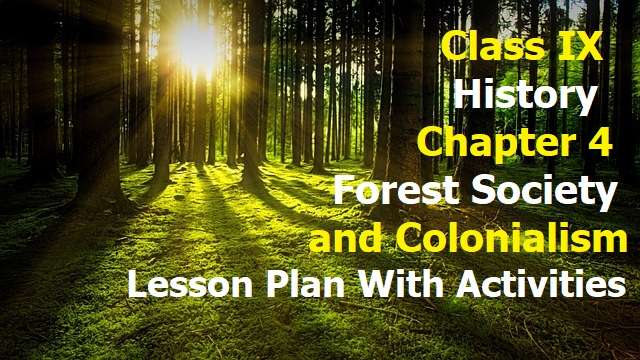Class IX History Lesson Plan Of Forest Society and Colonialism
The chapter “Forest Society and Colonialism” investigates how colonial control affected forest regions and the native peoples that lived there. Colonial powers heavily exploited forest resources through actions like deforestation and the creation of industrial plantations, all driven by economic considerations. This lesson on Colonialism and Forest Society is tailored to your pupils’ individual needs and skills as a teacher. The pace of the class and level of knowledge were taken into consideration when creating the lesson plan. To increase student engagement and learning, teachers might shorten the duration of each activity or add new ones.
The subject of the Forest Society and Colonialism is significant and timely. Colonialism’s impact on forest societies is still felt today. The legacy of colonialism in forest societies continues to shape debates around sustainable development, resource management, and the rights of indigenous peoples.
The French Revolution Lesson Plan For Class IX : As Per CBSE Guidelines
Class IX History Lesson Plan Of Forest Society and Colonialism
Class: IX (9th Grade)
Subject: History
Topic: Forest Society and Colonialism
Objective:
The objective of teaching the chapter “Forest Society and Colonialism” is to create interest in the subject.
Also to make the students aware of our past.
By the end of this lesson, students will be able to:
- Understand the impact of colonialism on forest societies.
- Analyze the changes brought about by colonial rule in forest regions.
- Identify the consequences of the exploitation of forest resources during colonial times.
Materials Required:
- PowerPoint presentation (PPT)
- Map of forest regions (Smart Board)
- Images of colonial practices in forest societies.
- Handouts with relevant information
Duration: 60 minutes
Procedure: Day 1
Methodology:
Interactive method will be used.
Introduction (10 minutes)
- The teacher will begin the lesson by engaging students in a brief discussion about forests and their significance in society.
- Ask students if they are aware of any historical events or processes that impacted forest societies.
- Introduce the topic of forest society and colonialism, explaining that it focuses on how colonial rule affected forest regions and their inhabitants.
Key Concepts and Terminology (15 minutes)
- Here, the teacher plans to provide a brief overview of key concepts and terminology.
- It will be related to the topic, such as forest societies, colonialism, exploitation, and indigenous communities.
- Also will define these terms and ensure students have a clear understanding of their meaning.
Historical Context (10 minutes)
- The teacher here provide a historical background of colonialism and its expansion into forest regions.
- Also discuss the motives behind colonial powers’ interest in forest resources (e.g., timber, spices, trade routes).
- Lastly, explain how colonial powers established control over forest regions and the impact it had on indigenous communities.
Procedure: Day 2
Methodology:
Interactive method will be used.
Impacts of Colonial Rule (15 minutes)
- On the second day, the teacher will revise the topics discussed yesterday by asking a few basic questions.
- Then, present information and examples of the impacts of colonial rule on forest societies.
- Will discuss how colonial powers exploited forest resources.
- This includes deforestation, establishment of plantations, and extraction of valuable minerals or natural resources.
- Finally will show images or photographs depicting the changes brought about by colonial practices in forest regions.
PowerPoint Presentation (20 minutes)
- The teacher will use a PowerPoint presentation to provide an overview of forest society and colonialism.
- Will discuss the reasons why colonial powers were interested in forest regions (e.g., timber, spices, trade routes).
- Also will highlight the strategies employed by colonial powers to exploit forest resources. (e.g., deforestation, introduction of commercial plantations).
- Present images and examples to illustrate the impact of colonial practices on forest societies.
- Finally will emphasize the economic, social, and ecological consequences of colonial exploitation.
Procedure: Day 3
Class Test: You can’t do it in 15 minutes.
The teacher will conduct a class test by preparing the following questions.
These questions are intended to assess knowledge and understanding of the topic.
Students to solve these questions in pair.
Two students together will find the answers of these questions in 15 minutes.
In this way the teacher gives a challenge to the students to complete the test in 15 minutes.
Fill in the blanks:
- The colonial powers exploited the forests primarily for _______________ resources.
- The _______________ people often faced displacement due to colonial policies on forest management.
- Forests were seen as valuable resources for the colonial powers’ _______________ industry.
- The establishment of _______________ in colonies contributed to deforestation and ecological damage.
- The _______________ Act of 1878 in India restricted access to forests and affected the livelihoods of local communities.
- The British colonial administration imposed _______________ on forest resources, leading to conflicts with indigenous communities.
- The exploitation of forests by colonial powers led to the erosion of traditional _______________ and knowledge systems.
- The colonial powers introduced _______________ species to the colonies, which often disrupted the native ecosystems.
- Indigenous communities relied on forests for their _______________ and cultural practices.
- The resistance movements against colonial forest policies were often led by _______________ communities.
Answer in One word:
The the students complete the fill in the blank questions, the teacher hand over another set of 10 questions.
Students have to find an appropriate answer to these questions. (Answers to be hidden)
- What is the primary motive behind colonial exploitation of forests? (Resources)
- Who often faced displacement due to colonial forest management policies? (Indigenous)
- What industry was heavily dependent on forests during the colonial period? (Timber)
- What institutions contributed to deforestation and ecological damage in colonies? (Plantations)
- Which act in India restricted access to forests and affected local communities? (Forest)
- What did the colonial administration impose on forest resources, leading to conflicts? (Restrictions)
- What was eroded by the exploitation of forests by colonial powers? (Traditions)
- What type of species did colonial powers introduce to colonies, disrupting native ecosystems? (Alien)
- What did indigenous communities rely on forests for? (Livelihood)
- Who often led resistance movements against colonial forest policies? (Communities)
Through play way method or gamification, students can learn many things.
Group Activity
Mapping Colonial Impact (15 minutes)
- Divide the students into small groups.
- Provide each group with a map of forest regions during colonial times.
- Instruct the groups to identify and mark areas where significant changes occurred due to colonial practices.
- Encourage them to discuss and share their findings within the group.
- Afterward, ask a representative from each group to present their findings to the class.
Procedure: Day 4
Class work:
On the fourth day the teacher comes prepared with ten short answer questions related to “Forest Society and Colonialism”.
These QUESTIONS / WORKSHEETS have to be answered in approximately 30 words or less in one period.
Students can take the help of text-book in finding these answers.
- How did colonial powers exploit forests for economic gain?
- What were some of the consequences of colonial forest policies on indigenous communities?
- How did the establishment of plantations contribute to deforestation and ecological damage?
- What was the impact of the Forest Act of 1878 on local communities in India?
- How did colonial administrations restrict access to forest resources?
- What were some conflicts that arose between indigenous communities and colonial powers over forest resources?
- How did the exploitation of forests by colonial powers affect traditional knowledge and practices?
- What were the ecological implications of introducing alien species to colonial territories?
- What were some of the ways in which indigenous communities relied on forests for their livelihoods?
- Who were the key leaders of resistance movements against colonial forest policies?
Procedure: Day 5
Homework Planned
- The teacher selects any 4 important questions from the chapter “Forest Society and Colonialism”.
- Discussed every question in detail.
- Explains how to write the answers.
- Provide the students two days time to submit the homework.
Long answer type questions from “Forest Society and Colonialism”.
- Discuss the impact of colonial forest policies on indigenous communities and their livelihoods.
- Analyze the ecological consequences of colonial exploitation of forests.
- Assess the role of resistance movements in challenging colonial forest policies.
- Discuss the long-term legacy of colonial forest policies on present-day forest societies.
Procedure: Day 6
Group Activity:
Topic: Analyzing Consequences (15 minutes)
Firstly, the teacher will divide the students into small groups.
Secondly, provide each group with a set of questions or a worksheet related to the consequences of colonialism on forest societies.
Thirdly, Instruct the groups to discuss and answer the questions collaboratively.
Next, encourage them to consider the economic, social, and ecological consequences of colonial exploitation.
Finally, ask each group to share their findings with the class.
Gamification In Social Science: From Boredom to Brilliance
Class Discussion (15 minutes)
Initiate a class discussion based on the group presentations.
Encourage students to share their observations, ask questions, and discuss the impact of colonialism on forest societies.
Facilitate a conversation about the long-term consequences of colonial exploitation and whether any remnants of these practices still exist today.
Learning Outcome:
After reading the chapter “Forest Society and Colonialism,” here are four potential learning outcomes:
- Children will understanding the impact of colonialism on forest societies:
- will be able to examine the strategies and policies employed by colonial powers:
- Can recognizing resistance and contestation by forest communities:
- will be able to assess the legacy of colonialism in contemporary forest issues:
Remedial Measures:
Think, Pair and share
After the completion of the chapter “Forest Society and Colonialism,” the teacher will adopt “Think, Pair and Share” method of learning.
It is a valuable approach for weak students as it promotes active engagement, collaboration, and peer support.
Here’s how the Pair and Share method will be implemented:
Pairing students
Assign weak students to work in pairs with stronger or more confident classmates.
Sharing information
a specific topic or question will be provided. Each pair should discuss the topic, share their knowledge, insights, and understanding with each other.
Active discussion
discuss the topic, asking each other questions, clarifying doubts, and elaborating on their thoughts.
Collaborative learning
collaboration helps weaker students grasp the content more effectively and build their understanding through the support of their partner.
Peer Feedback
After completing the task, encourage pairs to provide feedback to each other
This method will create a supportive learning environment. Slow learners can benefit from the knowledge and guidance of their peers. It will foster active participation, boosts confidence, and promotes collaborative learning, ultimately helping weaker students improve their understanding of the subject matter.
Gamification In Social Science: From Boredom to Brilliance
Conclusion and Reflection (5 minutes)
- Teacher summarizes the key points discussed in the lesson.
- Revisit the objectives and ask students if they feel they have achieved them.
- Thereafter, encourage students to reflect on what they have learned and how it relates to the present-day management of forest resources.
- Further, assign a short written reflection for homework, asking students to share their thoughts on the topic.
- Finally, address any remaining questions or concerns.
You may be interested in:
Class IX Chapter 3 Nazism and the Rise of Hitler Lesson plan
Class IX Chapter 2 History – Socialism In Europe And The Russian Revolution Lesson Plan
The French Revolution Lesson Plan For Class IX : As Per CBSE Guidelines





0 Comments